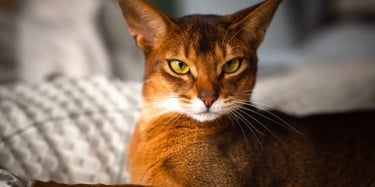
This breed are strikingly wild looking, the Abyssinian gives the impression of an extreme athlete who has just wandered in from the jungle. From the large ears, small oval feet and long slender tail, the Abyssinian is covered in fine, short and glossy coat, lithe and long, with a lean, muscular build and moderately wedge-shaped head and large, almond shaped eyes, the Abyssinia is a super model of a cat.
The Abyssinian’s fur carries bands of color giving her a richness and depth not seen in other breeds. The Abyssinian is a medium-sized cat with a long and nicely developed muscles. She is an active cat that loves to jump and play.
If you’re a pet lover or an admirer of the different cat breeds, learning interesting information about Abyssinian cats will be exciting for you.
ABYSSINIAN OVERVIEW
Official name Abyssinian
Common name Abyssinian
Pet weight 8-12 pounds
Pet height 8-10 pounds
Lifespan 9-13 years
Good with Cats, dogs and families
Temperament Sociable
Intelligence High
Playfulness High
Shedding amount Seasonal
Energy level Active
Coat length Short
Colors Brown /sable /fawn/ orange/ chocolate/ red
Patterns Tabby
Other traits Very easy to groom, train, and its friendly toward humans, and other pets, with very strong loyalty tendencies.
History
The Abyssinian cat has a rich but controversial history. There are different theories about the origination of this cat breed.
According to a group, the Abyssinian cats are the oldest domestic cats, and their traces are found back ancient Egyptian times. Archeologists have been studying the mummified cats in the Egyptians tomb that resembles the Abyssinians cats.
Another concept highlights that the origination of an Abyssinian cat happened along the Indian Ocean and the parts of Southeast Asia.
According to the current concept of the existence of the Abyssinian cats, professionals say that the cat breed was promoted by the British, but during World War II, it was decimated. In 1860s, a cat was brought to Britain by Lord Robert Napier following a military expedition to Abyssinia. This cat was named Zulu and she was the foundation of the beautiful breed known today as Abyssinia.
PERSONALITY
Abyssinian cats are a courageous, high-spirited, and struggle-free breed that are cheerful in nature and are known to keep itself entertained. This breed are not considered selfish or aloof as they can be really affectionate and devoted to their owner. Being an active breed, Abyssinian cats are always perform antics as a way of entertainments, owners of this breed calls them clowns of the cat world.
Their investigative nature makes them unique and attractive, how they follow you around the house to keep watch on how you are doing. This breed are very athletic and really smart. Confining these cats to a cupboard or a closed room is not the advisable, as their agile paws and exploring mind will defeat all the barriers and hindrances.
Unlike other cat breeds that are comfortable around humans and provide companionship. Abyssinians cats are not like that, they hardly sit on human laps nor allow themselves to be cuddled as they are not really friendly.
DIET AND NUTRITION
Your cats dietary needs will depend largely on its age, sex, and activities. Consult your veterinarian on how best to feed your Abyssinian. Note: overfeeding can lead to dangerous health conditions associated to obesity.
ABYSSINIAN CARE
Like all cats, it’s important to develop a regular oral health routine. Daily brushing is ideal, but even brushing once a week can help protect your cat from periodontal disease.
The Abyssinian are really-low maintenance cat, they are active, playful, and appreciate cat toys with very interactive playtime. Despite their high need for exercise and energy levels, they don’t need frequent grooming, weekly combing and occasional baths can help remove dander, debris, and loose hair. It is also a good idea to invest in cat tree or wall-mounted shelves, so your cat has high places to climb and perch.
TEMPERAMENT
Abyssinians are incredibly smart and curious animal, this makes them natural explorers. They tend to be at every corner of your home, on every possible surface, regardless of accessibility.
They are renowned for their social abilities, making play time very enjoyable. They are very amusing but also need a lot of amusement. It’s a very strong companion cat, always on the laps of their pet parent.
HEALTH
Abyssinian are known for their healthy nature. But here are still some conditions pet parent need to watch out for;
• Patellar Luxation: A kneecap dislocation that can range from mild to severe lameness. Surgery might be required to correct this condition.
• Renal Amyloidosis: A genetic disorder in which deposits of a protein called amyloid build up in organs, particularly in the kidney, which eventually leads to kidney failure.
• Osteoarthritis: A painful joint condition that is common in all cats, especially as they age. Signs include: difficult jumping, running, or walking through the stairs.
• Kidney Disease: In aging cats this disease are common. Signs include: frequent urinating, dull or thinning hair, lack of energy, mouth ulcers , increase thirst and vomiting
• Progressive Retinal Atrophy: this refers to a group of genetic disorders leading to reduces vision or loss of vision.
The Abyssinian played a key role in developing Australia’s first pedigreed breed of cat, the Australian Mist, which is a Burmese/Aby mix.